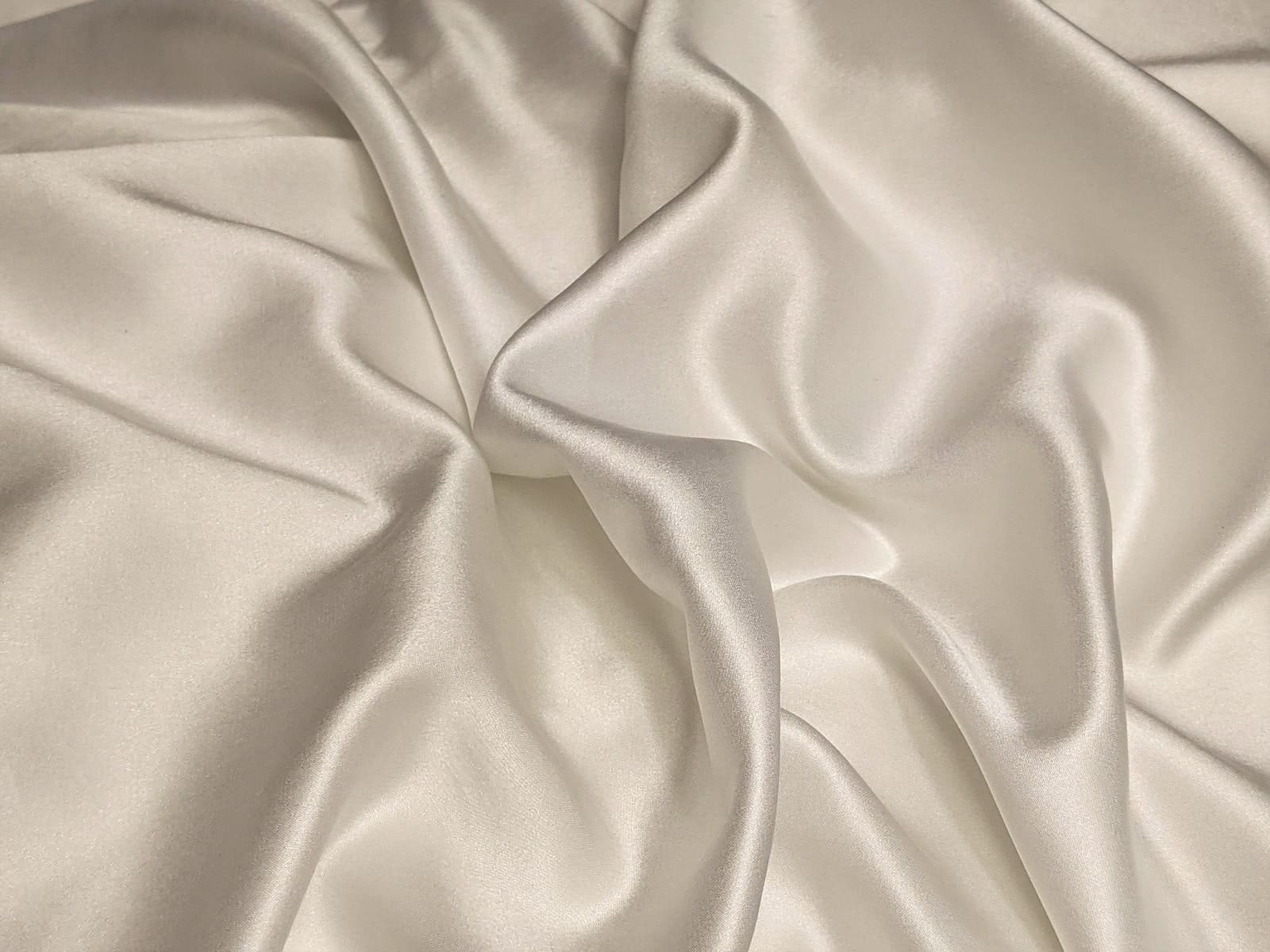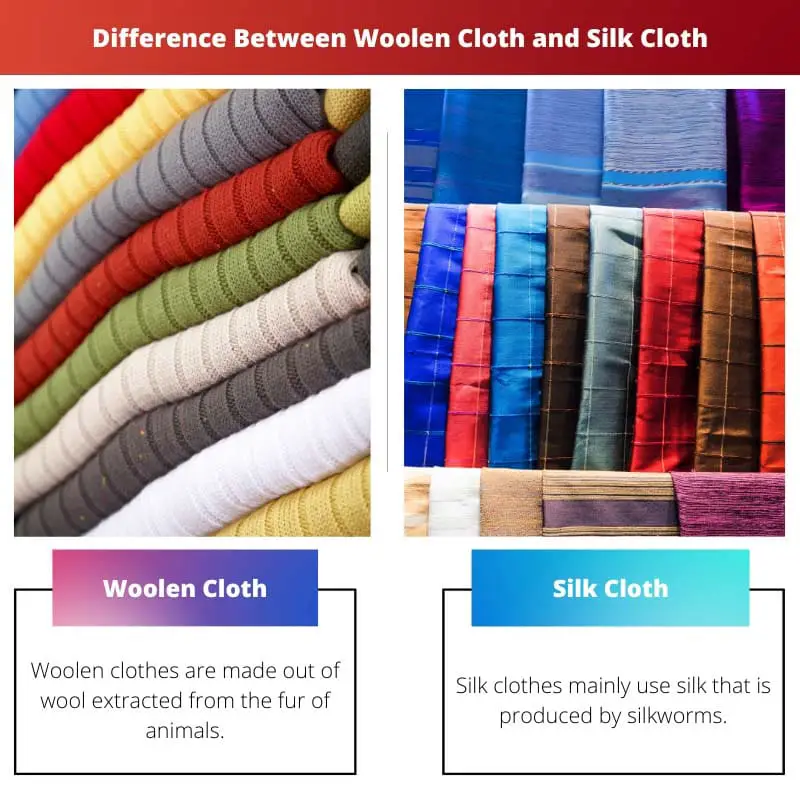Clothes made out of different fabrics are used at different times of the year because of the difference in purpose. In summers we need light clothes whereas in winters warm clothes keep us away from the cold.
Woolen and silk clothes are two different types of clothing made with different materials.
Key Takeaways
- The woolen cloth provides better insulation and warmth than silk cloth.
- Silk cloth has a smoother texture and a more luxurious appearance than woolen cloth.
- The wool comes from sheep, whereas silk originates from silkworms.
Woolen Cloth vs Silk Cloth
Woolen cloth is made from the fleece of sheep, while silk cloth is made from the cocoon of the silkworm. Woolen cloth has a coarse texture, while silk cloth has a smooth, silky texture. Woolen cloth is a good insulator and is ideal for cold weather, while silk cloth is lightweight.

Woolen clothes are mainly made out of the fur of animals like sheep, goats, and camels. It is highly stretchable and durable. Wool generates a lot of heat that keeps our bodies warm in winter.
The quality of wool can be identified by the length, color, origin, and fineness of the wool.
Silk clothes are highly expensive because only the silk off the silk warns can be used for making silk clothes which is very rare to find. It is extremely light soft to the skin. The shine factor of silk clothes enhances the beauty of the person who wears them.
Comparison Table
| Parameters of Comparison | Woolen Cloth | Silk Cloth |
|---|---|---|
| Material | Woolen clothes are made out of wool extracted from the fur of animals. | Silk clothes mainly use silk that is produced by silkworms. |
| Types | Shetland wool, Lambswool, Cashmere wool, etc. | Chiffon, georgette, organza, crepe etc. |
| Warmth | Woolen clothes keep us warm. | Silk clothes generate heat but not as much as woolen clothes. |
| Shine | Woolen clothes do not have shine. | Silk clothes are known for their shine. |
| Durability | Woolen clothes are more durable. | Silk clothes are not as much as woolen clothes. |
What is Woolen Cloth?
Woolen cloth is essentially made out of wool, which is a type of fabric made from the fur of animals like sheep, goats, camels, musk oxen, etc.
Woolen clothes are mostly used during wintry days to protect our bodies from the cold. It is unimaginably warm. But the intensity of warmth mostly depends on the type of wool that has been used.
Various kinds of wool-like lambswool are made out of the fur of young sheep. Shetland wool comes from all the way from Scotland, mohair from goats, cashmere from Kashmir, and the list goes on.
Wooden clothes are knitted by hand, but now there are also different designs of ready-made woolen clothes available on the market.
The durability and stretchability of wool are higher than most of the other available fabrics used for clothing. It generates a good amount of heat for the body and is also very soft to the skin.
It can also absorb water and does not leave shape even after using it hundred times.
However, the quality of the wool is identified by the length, color, source, and fineness of the wool. One of the interesting facts about wool is that if you rub it with the proper pressure, it produces electricity, but it is static in nature.
The price of wooden clothes somewhat varies from expensive to moderate, but it mostly depends on the quality of the wool.

What is Silk Cloth?
It is the worms or insects that create silk which is basically their larvae. There are various kinds of silk found in nature, but all of them cannot be used to make silk clothes. It is only the silk of the silkworms that is used to produce the finest silk clothing.
The most popular forms of silk fabric r chiffon, crepe, brocade, organza, georgette, taffeta, etc. Fibroin is the main fiber present in silk and is considered one of the strongest fabric materials of all.
Silk is highly stretchable, extremely smooth, and soft on the skin. Silk clothes add a sense of elegance to the body and are extremely light in weight.
Like wool, it also produces warmth, if not as much as wool. It is a type of fabric that can be used for both traditional and western clothes like shirts, blouses, suits, sarees, pajamas, designer clothes, etc.
But silk is very delicate in nature. It can lose its shine and strength if it is too exposed to sunlight.
Silk clothes can be worn even in summers. It can be reused in winters as it equally keeps the body warm. Silk clothes never fall out of fashion because of the texture and the attractive look it adds to the person who wears them.

Main Differences Between Woolen Cloth and Silk Cloth
- Woolen clothes are made out of different types of wool. Silk clothes are woven by the silk of the silkworms.
- There are different types of wool such as Shetland wool, lambswool, Cashmere wool, etc. There are different forms of silk clothes such as chiffon, georgette, crepe, organza, etc.
- Woolen clothes are only for winter use. But silk clothes can we warn during boots summer and winter days.
- Woolen clothes generate heat more than silk clothes.
- Wooden clothes are highly durable and stretchable. But still, clothes need special care as it wears out and loses their color with too much sun exposure.

- https://journals.sagepub.com/doi/abs/10.1177/004051756303300910
- https://onlinelibrary.wiley.com/doi/abs/10.1111/1346-8138.14124
